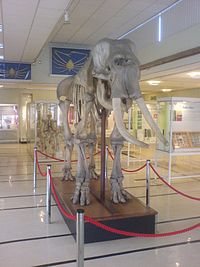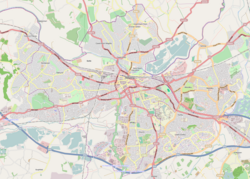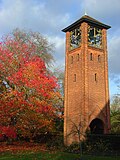
The Natural History Museum in London is a museum that exhibits a vast range of specimens from various segments of natural history. It is one of three major museums on Exhibition Road in South Kensington, the others being the Science Museum and the Victoria and Albert Museum. The Natural History Museum's main frontage, however, is on Cromwell Road.

The Hunterian is a complex of museums located in and operated by the University of Glasgow in Glasgow, Scotland. It is the oldest museum in Scotland. It covers the Hunterian Museum, the Hunterian Art Gallery, the Mackintosh House, the Zoology Museum and the Anatomy Museum, which are all located in various buildings on the main campus of the university in the west end of Glasgow.

World Museum is a large museum in Liverpool, England which has extensive collections covering archaeology, ethnology and the natural and physical sciences. Special attractions include the Natural History Centre and a planetarium. Entry to the museum is free. The museum is part of National Museums Liverpool.

The Oxford University Museum of Natural History, sometimes known simply as the Oxford University Museum (OUMNH), is a museum displaying many of the University of Oxford's natural history specimens, located on Parks Road in Oxford, England. It also contains a lecture theatre which is used by the university's chemistry, zoology and mathematics departments. The museum provides the only public access into the adjoining Pitt Rivers Museum.

The National Museum of Natural History is a natural history museum administered by the Smithsonian Institution, located on the National Mall in Washington, D.C., United States. It has free admission and is open 364 days a year. In 2021, with 7.1 million visitors, it was the eighteenth most visited museum in the world and the second most visited natural history museum in the world after the Natural History Museum in London. Opened in 1910, the museum on the National Mall was one of the first Smithsonian buildings constructed exclusively to hold the national collections and research facilities. The main building has an overall area of 1.5 million square feet (140,000 m2) with 325,000 square feet (30,200 m2) of exhibition and public space and houses over 1,000 employees.
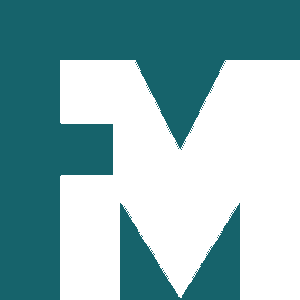
The Florida Museum of Natural History (FLMNH) is Florida's official state-sponsored and chartered natural-history museum. Its main facilities are located at 3215 Hull Road on the campus of the University of Florida in Gainesville.
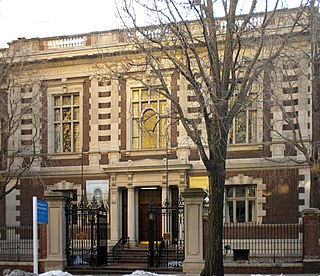
The Mütter Museum is a medical history and science museum located in the Center City area of Philadelphia, Pennsylvania. It contains a collection of anatomical and pathological specimens, wax models, and antique medical equipment. The museum is part of The College of Physicians of Philadelphia. The original purpose of the collection, donated by Dr. Thomas Dent Mütter in 1858, was for biomedical research and education.
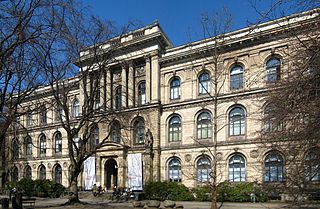
The Natural History Museum is a natural history museum located in Berlin, Germany. It exhibits a vast range of specimens from various segments of natural history and in such domain it is one of three major museums in Germany alongside Naturmuseum Senckenberg in Frankfurt and Museum Koenig in Bonn.

The Grant Museum of Zoology and Comparative Anatomy is a natural history museum that is part of University College London in London, England. It was established by Robert Edmond Grant in 1828 as a teaching collection of zoological specimens and material for dissection. It is one of the oldest natural history collections in the UK, and is the last remaining university natural history museum in London. Notable specimens and objects held by the museum include a rare quagga skeleton, thylacine specimens, dodo bones and Blaschka glass models.

The Denver Museum of Nature & Science is a municipal natural history and science museum in Denver, Colorado. It is a resource for informal science education in the Rocky Mountain region. A variety of exhibitions, programs, and activities help museum visitors learn about the natural history of Colorado, Earth, and the universe. The 716,000-square-foot (66,519 m2) building houses more than one million objects in its collections including natural history and anthropological materials, as well as archival and library resources.

The National Museum of Ireland – Natural History, sometimes called the Dead Zoo, a branch of the National Museum of Ireland, is housed on Merrion Street in Dublin, Ireland. The museum was built in 1856 for parts of the collection of the Royal Dublin Society and the building and collection were later passed to the State.
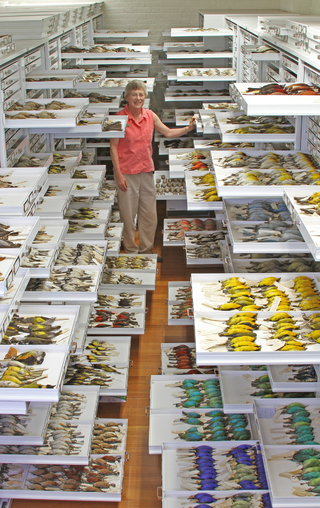
The Museum of Comparative Zoology is a zoology museum located on the grounds of Harvard University in Cambridge, Massachusetts. It is one of three natural-history research museums at Harvard, whose public face is the Harvard Museum of Natural History. Harvard MCZ's collections consist of some 21 million specimens, of which several thousand are on rotating display at the public museum. In July 2021, Gonzalo Giribet, Alexander Agassiz Professor of Zoology at Harvard and Curator of Invertebrate Zoology, was announced as the new director of the museum.

The Museo di Storia Naturale di Firenze is a natural history museum in 6 major collections, located in Florence, Italy. It is part of the University of Florence. Museum collections are open mornings except Wednesday, and all day Saturday; an admission fee is charged.

The Harvard University Herbaria and Botanical Museum are institutions located on the grounds of Harvard University at 22 Divinity Avenue, Cambridge, Massachusetts. The Botanical Museum is one of three which comprise the Harvard Museum of Natural History.

The Sedgwick Museum of Earth Sciences, is the geology museum of the University of Cambridge. It is part of the Department of Earth Sciences and is located on the university's Downing Site in Downing Street, central Cambridge, England. The Sedgwick Museum is the oldest of the eight museums which make up the University of Cambridge Museums consortium.
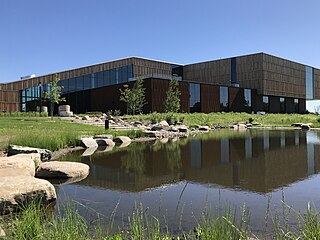
The Bell Museum, formerly known as the James Ford Bell Museum of Natural History, is located at the University of Minnesota. The museum's new location on the St. Paul campus opened July 13–15, 2018. The Minnesota wildlife dioramas, showcases numerous animal specimens from all over the world, and the 120-seat digital Whitney and Elizabeth MacMillan Planetarium theater is a highlighted feature of the new facility. The museum is part of the university's College of Food, Agricultural and Natural Resource Sciences. The museum's former location in Minneapolis is closed as the work to move to the University of Minnesota's St. Paul campus began in January 2017.

The Museum of Evolution of Uppsala University is a natural history museum in Sweden containing the largest fossil collection in Scandinavia. The number of items in today's collection, which spans zoological, paleontological and mineralogical specimens, is approximately 5 million unique pieces, of which only a fraction are exhibited. Expeditions to China in the 20th century unearthed numerous unique paleontological treasures. The museum's collection contains three teeth of the Peking Man, found by paleontologist Otto Zdansky during an expedition to Zhoukoudian in 1921. Due to its large collection of type specimens the museum is an important establishment in the field of biological systematics, and it maintains an active exchange with other scientific institutions worldwide.

The University Museum of Zoology is a museum of the University of Cambridge and part of the research community of the Department of Zoology. The public is welcome and admission is free (2018). The Museum of Zoology is in the David Attenborough Building, formerly known as the Arup Building, on the New Museums Site, just north of Downing Street in central Cambridge, England. The building also provides a home for the Cambridge Conservation Initiative, a biodiversity project.

A scientific collection is a collection of items that are preserved, catalogued, and managed for the purpose of scientific study.
The Museum of Life Sciences is a life science and natural history museum that is part of King's College London in London, England. It is housed on the Guy's Campus, adjacent to the Gordon Museum of Pathology in the Hodgkin Building. It was founded in 2009 and is the first new museum in King's College for over 100 years. It exists to explain the diversity of animal and plant life in the context of the biological and health sciences. The current curator is Dr Gillian Sales.
